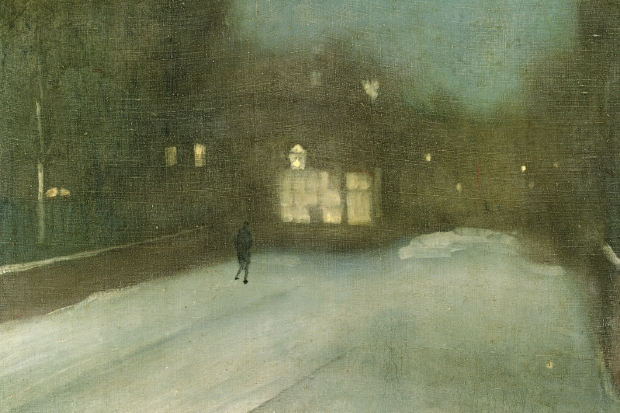‘A foggy day in London town,’ croons Fred Astaire in the 1937 musical comedy A Damsel in Distress, puffing nonchalantly on a cigar as he wanders through a wood that has already been half obliterated by belching Hollywood smoke machines. Today Gershwin’s lyrics conjure up a nostalgic vision of life in the city, involving pale fingers of fog wrapping themselves around lamp posts and the muffled clop of hooves on cobbles.
Actually, for many years the reality of a London fog was far less appealing. It clogged your lungs and made your eyes smart; it turned the air into a murky kaleidoscope of colours (yellow, grey, blue) that appeared to be on the verge of turning into a solid. You didn’t need to be Fred Astaire to ‘[view] the morning with alarm’ or wonder ‘how long would this thing last’.
As Christine L. Corton shows in her lively and engaging cultural history, for more than 100 years London fog did not only creep into people’s homes and bodies. It saturated their way of thinking. If fog was an inescapable part of city life — in Dickens’s famous opening to Bleak House, the word is repeated so often it sounds more like a curse — it was an equally omnipresent element in the cultural imagination.
The Thames had always produced natural fogs; visiting London in 1791, Haydn reported one that was so thick ‘one might have spread it on bread’. However, the industrial revolution soon gave birth to a new form of man-made weather. Thousands of chimneys created a pall of thick black smoke that, under certain atmospheric conditions, trapped sulphurous emissions and particles of soot at ground level. It was a form of airborne mess that was much easier to make than to clean up. By the 1840s, the Big Smoke was rapidly becoming the Big Choke, and while the politicians dragged their heels, nervous about offending powerful industrialists, London slowly submitted to fog’s gloomy embrace.
‘Fog’s formlessness,’ Corton points out, ‘lent itself to a wide variety of representations’, such as the fear that often it spread across London from the poverty of the East End, like a stain on the city’s conscience, and ecological fables that imagined a tremendous future fog wiping out the city’s inhabitants in a matter of days. And while fog confused physical outlines — Corton reproduces a Punch cartoon that depicts the silhouette of a man carrying a cello over his shoulder, who appears to be three soldiers in bearskin hats — it also encouraged writers and artists to distinguish themselves from each other. In Dr Jekyll and Mr Hyde, fog is the setting for a story of degeneracy and murder; in a painting like Whistler’s ‘Nocturne in Grey and Gold — Piccadilly’, on the other hand, fog moves centre stage. With its ability to smudge the contours of reality, no longer is fog merely the backdrop to Whistler’s real subject. It is his subject.
In mapping out this imaginative terrain, Corton has a similarly sharp eye, noticing details such as the protective goggles that were sold as ‘fog glasses’ in the 1870s, and Nathaniel Hawthorne’s wonderful 1857 description of London’s greasy air as ‘the ghost of mud, the spiritualised medium of departed mud’. She is perhaps better as a cultural historian than a literary critic, introducing each novel with a rather clunking plot summary, but even when dealing with well-known literary works she often notices things about them that reproduce another of fog’s characteristic effects. It makes us feel like strangers in a world we thought we knew.
By the 1960s, legislation such as the 1956 Clean Air Act meant that London’s fogs had largely been consigned to the dustbin of history. They could even be turned into a joke, like the can of ‘Fresh London Fog’ that was advertised in an American newspaper, accompanied by a testimonial from ‘a charming gentleman called Sir Foggy-Fogget’. Not foggy-forget, though, because even if the London fog had disappeared from the skies it continued to linger in the public imagination.
Today no film about Jack the Ripper would be complete without a swirl of sour yellow fog, even though all the Ripper’s murders took place on clear nights. Sherlock Holmes, similarly, is almost always accompanied by fog on screen, a companion no less reliable than the trusty Dr Watson, despite the fact that Conan Doyle rarely mentions it in his writing.
‘Foggy London town is no more,’ Corton states in her final sentence, but her book actually pushes towards a rather different conclusion. Switch on the television, or open a novel set in the past, and it quickly becomes evident that fog has become far more than just a local quirk in the weather. It is central to the nation’s cultural atmosphere, part of the air we breathe.






Comments